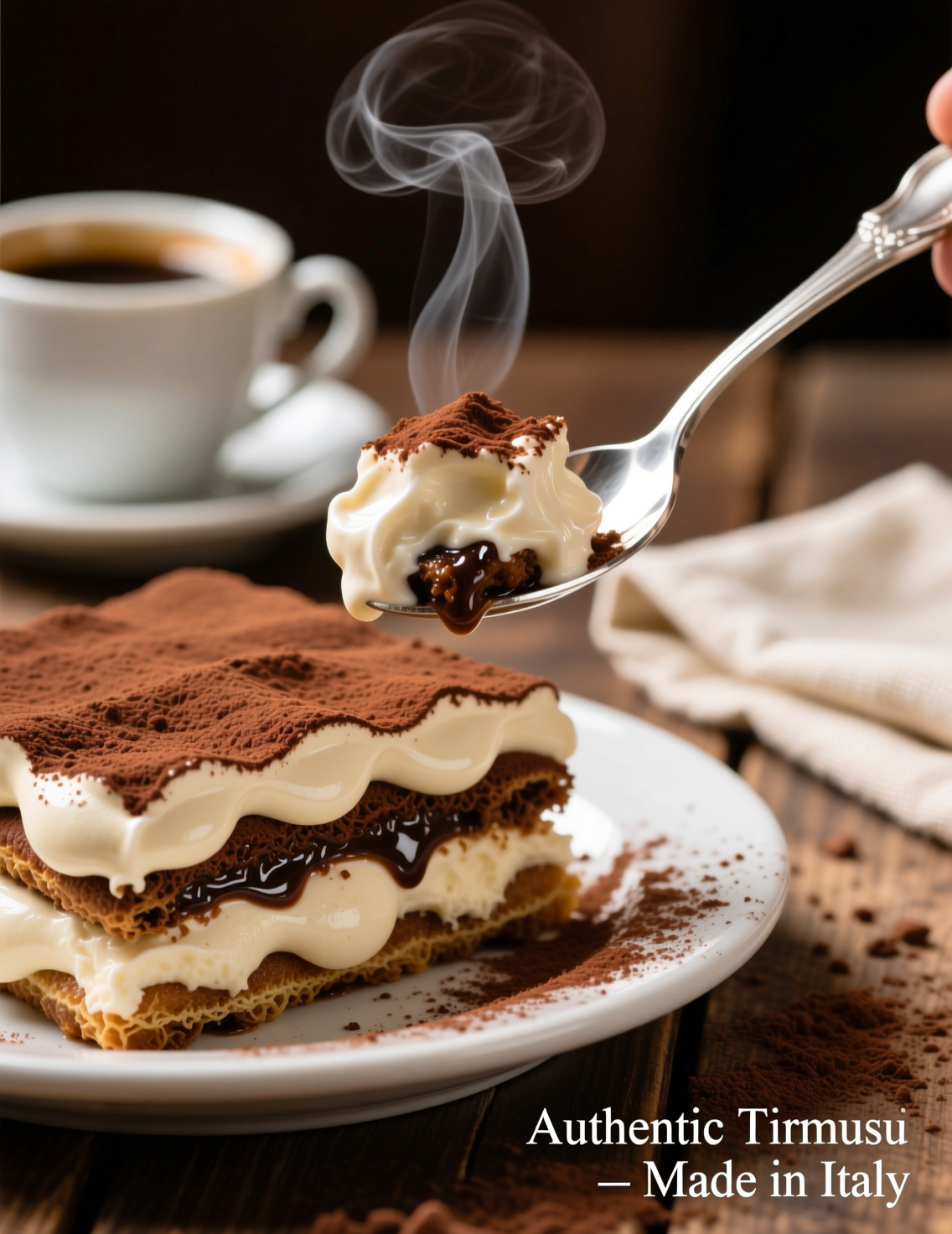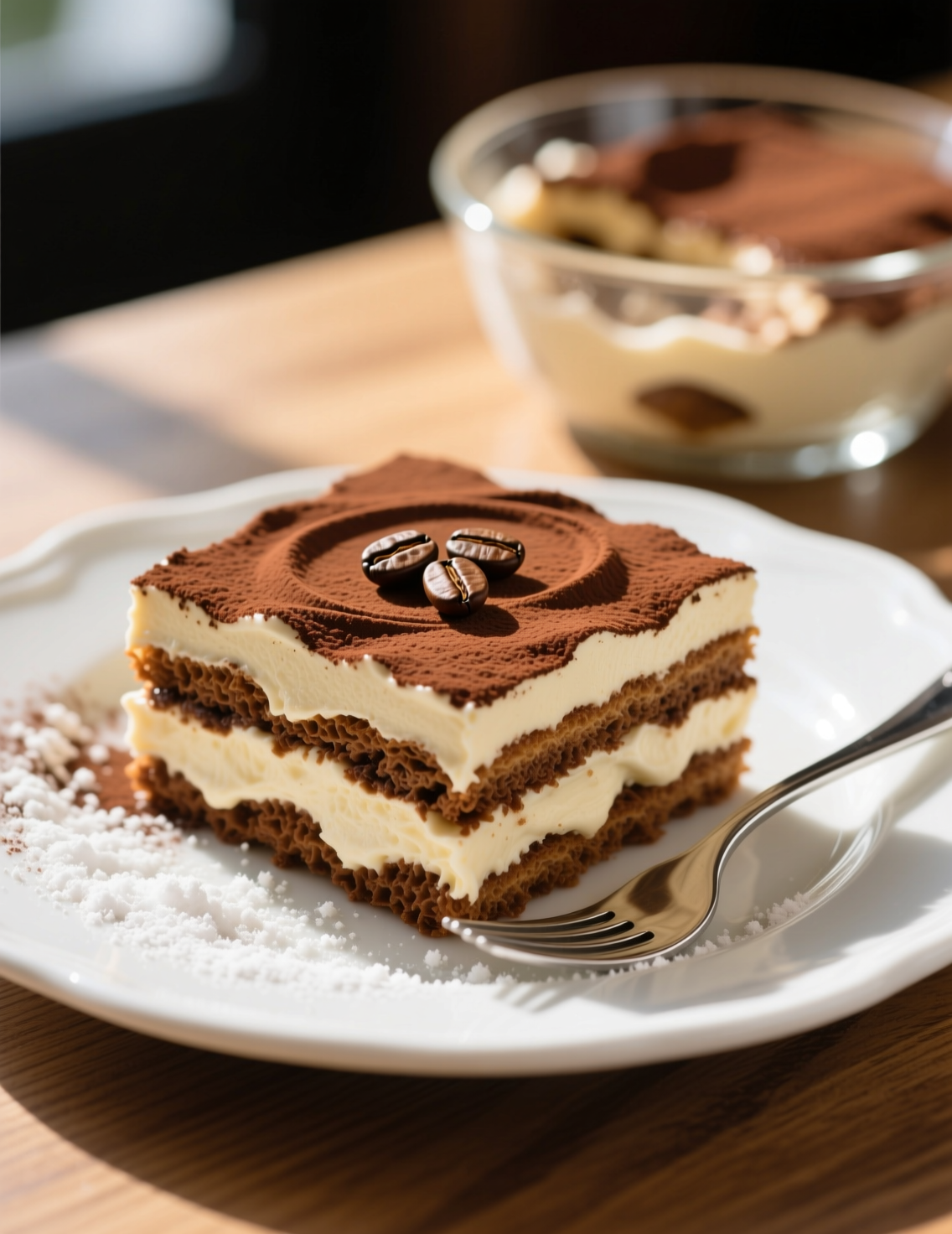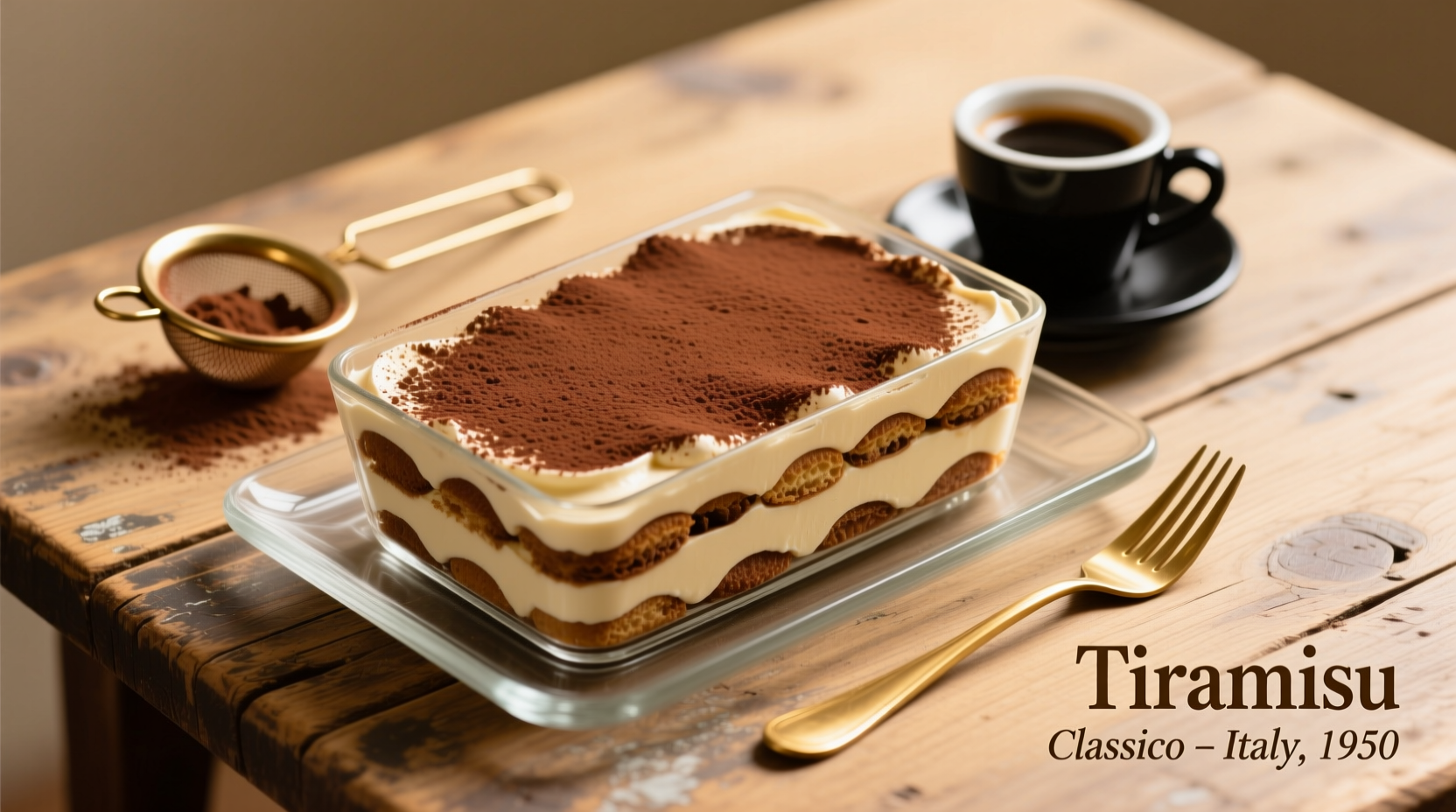There’s something quietly seductive about tiramisu. The way the mascarpone cream melts against coffee-soaked ladyfingers—it’s poetry, edible poetry. And no, this isn’t just dessert. It’s Italy’s whispered love letter to coffee, cream, and time itself. Today, we’ll dive deep into crafting a classic Italian tiramisu that does justice to its heritage—silky, airy, and unapologetically rich. Not that overly sweet, dense version you find in corner cafés. The real thing.
The Heart of the Dish: What Makes Tiramisu, Tiramisu
Tiramisu, meaning “pick me up,” was born in Treviso, Italy, sometime in the 1960s—though Venetians and Tuscans still argue over who did it first. What defines it? Espresso-soaked ladyfingers, a luscious mascarpone cream, and a dusting of cocoa. No baking. No shortcuts. Just layering perfection.
The soul of tiramisu lies in balance—bitterness from espresso, sweetness from sugar, silkiness from mascarpone, and the faint buzz of Marsala or coffee liqueur. Miss that harmony, and the dish collapses into mediocrity.
Why Mascarpone Cream Matters (and Why You Can’t Replace It)
Mascarpone isn’t cream cheese, though people like to think so. It’s richer, smoother, and holds structure without stiffness. Made from heavy cream curdled with lemon juice, it has this buttery flavor that’s essential to tiramisu’s charm. You could technically use cream cheese, sure—but you’d be making something else entirely. A cousin, maybe. Not tiramisu.
In Italy, mascarpone is often sourced fresh from Lombardy dairies. Its fat content—around 60–75%—makes it dreamy when folded with whipped yolks and sugar. That’s where the magic happens: air and fat combining in the gentlest waltz.

Ingredients (for 8 Servings)
- 6 large egg yolks, room temperature
- ¾ cup (150g) granulated sugar
- 16 oz (450g) mascarpone cheese, chilled
- 1 ½ cups (360ml) heavy cream, cold
- 2 cups (480ml) strong espresso, cooled
- 2 tbsp Marsala wine or coffee liqueur (optional but heavenly)
- 2 packs (about 40–45) ladyfingers (Savoiardi)
- Unsweetened cocoa powder, for dusting
That’s it. Simple, but deceptive. Tiramisu is all about how you treat those ingredients. The technique, not the list, makes the masterpiece.
Step 1: Crafting the Sabayon Base (Egg Yolk Mixture)
In a heatproof bowl, whisk yolks and sugar until pale and thick. Set the bowl over simmering water—don’t let it touch the surface—and whisk constantly. You’re not cooking the eggs; you’re coaxing them into silk.
After about 8 minutes, the mixture should double in volume and feel like satin. Remove from heat. Let it cool just slightly before adding mascarpone.
Most amateurs rush this. Don’t. The yolks need a moment to relax. Too hot, and your mascarpone splits. Too cold, and you’ll lose smoothness. Patience rewards you here.
Step 2: Folding in Mascarpone Like You Mean It
Once your sabayon is just warm, add mascarpone a spoonful at a time. Whisk gently until smooth. This is not a fight; it’s a love story. Overmixing kills the air.
Professional tip: always use chilled mascarpone—it blends smoother and holds shape better. You’ll notice the texture change as it thickens and glosses. That’s the sign of perfection.
Step 3: Whipping the Cream Just Right
Now, beat the cold heavy cream to soft peaks. Not stiff. You want it cloudlike, with a little give. Then fold it into the mascarpone mixture in three parts. Use a spatula and go slow—cut, lift, turn. Repeat.
This folding stage decides if your tiramisu is ethereal or stodgy. You’re incorporating air, not stirring soup. Some Italian chefs even chill the mixture for 30 minutes afterward, letting it set into a mousse-like body.
Step 4: Espresso Meets Savoiardi
Real tiramisu starts with espresso—nothing less. Brew it strong, then cool completely. Add a splash of Marsala or Kahlúa if you like complexity.
Dip each ladyfinger for just one second. That’s it. They should be moist, not drowning. Too long, and they’ll turn mush before they hit the plate. Arrange them neatly in a single layer in your dish.
Every Italian grandmother will tell you the same thing: “If the ladyfingers float, you’ve gone too far.”
Step 5: Layering Like an Artist
Spread half of your mascarpone cream over the first layer of soaked ladyfingers. Smooth gently. Then repeat—dip, layer, spread. Finish with a clean top of cream.
Now the waiting game begins. Refrigerate for at least 6 hours, though overnight is ideal. Tiramisu improves with time—the flavors meld, the texture deepens, the coffee and cocoa marry into something divine.
Step 6: The Final Dust
Right before serving, dust generously with unsweetened cocoa powder. Not too early—it’ll absorb moisture and lose that lovely velvety look. Use a fine sieve for that perfect snowfall effect.
Some chefs like to grate a few dark chocolate curls on top. I say, why not? It adds drama and a subtle bitterness that plays beautifully with the mascarpone.
The Science Behind the Texture
Tiramisu’s texture relies on three forces—emulsification, aeration, and fat balance. The yolk-sugar sabayon provides emulsification. Whipped cream introduces aeration. Mascarpone contributes fat and stability. Together, they form a matrix that feels light yet indulgent.
If your tiramisu turns runny, your yolks were undercooked or your cream overwhipped. Grainy? The mascarpone curdled—usually from mixing while too warm. Knowing these science bits helps you troubleshoot on instinct, not guesswork.
A Word on Eggs and Safety
Traditional tiramisu uses raw yolks, but modern food safety demands pasteurization. Either buy pasteurized eggs or heat the yolk-sugar mixture to 160°F while whisking. That keeps flavor intact without risk.
Many Italian restaurants now follow this method without compromising authenticity. The texture remains silken, the flavor pure.

Espresso Quality: Don’t Compromise
Instant coffee won’t do. Period. The espresso must be strong enough to punch through the cream but smooth enough not to overwhelm. Ideally, a blend of Arabica with a hint of Robusta for body.
If you don’t own an espresso machine, use a moka pot. Or cold brew concentrate—double strength. Just avoid bitterness from over-extraction. Italians are particular about this part for good reason—it defines the backbone of tiramisu’s flavor.
Choosing the Right Ladyfingers
Savoiardi, not the soft sponge kind. They must be crisp and dry. Why? Because they absorb liquid without collapsing. The brand matters less than their structure.
If you bake them yourself, even better. Freshly made Savoiardi are lighter, less sugary, and hold up beautifully after soaking. Professional pastry chefs often bake them thinner for a more refined texture.
Variations That Still Respect Tradition
Some chefs infuse the espresso with orange zest or replace Marsala with Amaretto. Others use shaved dark chocolate between layers. These touches modernize the flavor without betraying the roots.
However, whipped egg whites—though popular in American adaptations—aren’t traditional. They add air but reduce richness. Italians usually skip them, preferring the creamier yolk base.
Common Mistakes (and How to Dodge Them)
- Over-soaking ladyfingers: They’ll disintegrate, giving you a pudding, not a layered dessert.
- Using warm espresso: It melts the mascarpone layers and makes a soggy mess.
- Skipping the chill time: The flavors won’t mature, and the texture stays loose.
- Overwhipping cream: Makes the final cream grainy and stiff.
- Overmixing mascarpone: Causes splitting and oily separation.
Even pros slip here. The key is awareness, not perfection.
The Restaurant-Grade Finish
If you’re serving this professionally, assemble tiramisu in ring molds for individual portions. Chill overnight, unmold carefully, and dust right before plating. Pair with a drizzle of espresso reduction or cocoa nibs for texture contrast.
Temperature control is critical—serve at 45–50°F for the creamiest mouthfeel. Too cold and you lose the aroma; too warm and it collapses.
Nutritional Profile (Per Serving)
Approximate values for 1 of 8 servings:
- Calories: 510
- Fat: 35g
- Carbohydrates: 36g
- Protein: 7g
It’s indulgent, no denying that. But tiramisu isn’t meant to be guilt-free—it’s meant to be remembered.
Emerging Trends: Modern Takes on a Classic
Contemporary pastry chefs are reimagining tiramisu in bold ways—deconstructed versions, frozen tiramisu parfaits, or even vegan renditions using cashew cream. Yet, the heart remains the same: coffee, cocoa, and contrast.
One Michelin-starred restaurant in Milan even serves “tiramisu foam,” a molecular spin that captures the original flavor in a weightless form. It’s fascinating, but nothing replaces the comfort of the classic.
Storage and Shelf Life
Properly chilled, tiramisu lasts up to 3 days in the fridge. Beyond that, the ladyfingers begin to weep moisture, and the texture dulls. Never freeze it—ice crystals destroy the cream’s structure.
If you must prepare in advance, make the cream and soak the ladyfingers separately. Assemble the day before serving.
Cultural Significance and Why It Endures
Tiramisu is more than dessert—it’s identity. It represents Italy’s genius for transforming simplicity into elegance. No fancy tools, no exotic ingredients, just intuition and love.
It’s also a dessert of conversation. You don’t eat tiramisu alone. You share it—between espresso cups, laughter, and the hum of after-dinner talk. Maybe that’s its secret ingredient.
Final Thoughts: The Beauty of Simplicity Done Right
A well-made tiramisu doesn’t scream for attention—it whispers. Soft layers, honest flavors, perfect restraint. It’s not about reinvention but respect.
If you take anything from this, it’s this: quality ingredients, patient hands, and time. That’s all it asks of you. And when you finally lift that first creamy bite? You’ll know.
Because in that moment—coffee, cream, and cocoa all meeting on your tongue—you’ll taste Italy itself.
That’s tiramisu, the classic way. No tricks. No shortcuts. Just pure, timeless perfection.
FAQs
What is the key ingredient in classic Italian tiramisu?
Mascarpone cheese is the heart of authentic tiramisu, giving it its rich and creamy texture.
Can I replace mascarpone with cream cheese?
Not really—it changes the flavor and texture, making it less authentic and more dense.
How long should tiramisu chill before serving?
At least 6 hours, but overnight gives the best flavor and structure.
Can I make tiramisu without alcohol?
Yes, simply skip the Marsala or replace it with extra espresso for a non-alcoholic version.
Why did my tiramisu turn runny?
Likely because the egg yolk mixture was undercooked or the cream was overwhipped.
Can I use instant coffee instead of espresso?
It’s possible, but espresso gives the deep, bold flavor that defines true tiramisu.
How long does tiramisu last in the fridge?
Up to 3 days when covered properly, after which it starts losing texture.
Is tiramisu safe for kids to eat?
Yes, if you use pasteurized eggs and skip the alcohol, it’s perfectly fine.
Can tiramisu be frozen for later use?
Freezing is not recommended, as it ruins the creamy structure once thawed.
What kind of cocoa powder should I use on top?
Use unsweetened, high-quality cocoa for that deep, slightly bitter contrast.
Why do my ladyfingers get soggy?
They were soaked too long—just a quick dip in espresso is enough.
Can I make tiramisu without eggs?
Yes, but it won’t have the same richness; use whipped cream and mascarpone instead.
What’s the ideal serving temperature for tiramisu?
Slightly chilled, around 45–50°F, to preserve its texture and aroma.
What does “tiramisu” mean in Italian?
It literally means “pick me up,” referring to its energizing coffee flavor.
Is tiramisu originally from Venice?
It’s debated, but most believe it was first made in Treviso, near Venice.

Mariana is a passionate home cook who creates delicious, easy-to-follow recipes for busy people. From energizing breakfasts to satisfying dinners and indulgent desserts, her dishes are designed to fuel both your body and hustle.
When she’s not in the kitchen, she’s exploring new flavors and dreaming up her next recipe to share with the Foodie Hustle community.

